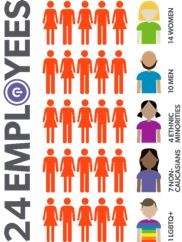By Deborah McMurray
Imagine this scenario: A lawyer receives an RFP from an existing client on Tuesday who wants to consolidate the number of outside law firms from 50 to 10. The RFP is due in three weeks. You have THREE WHOLE WEEKS to try to win this work!
According to two 2018 industry surveys, the ILTA 2018 Marketing Technology Survey[1] and the Content Pilot Flash Survey about Best Practices in Proposals and RFPs, only 25% of the nearly 170 respondents to both surveys have proposal automation tools in their firms. This means that this RFP response will likely be managed and assembled manually.
A marketer’s typical response to a large RFP may be to start with an old proposal and “save as” the new one – then, review it page by page updating firm and lawyer minutia that have changed.
Strategy 1:
I challenge you to reframe your thinking and approach. A proposal is an opportunity to reset an existing relationship – to start fresh. It’s an opportunity for your firm and lawyers to be better.
The problem with starting with existing material is that you aren’t refreshing your thinking for this particular client – you’re just focusing on the lowest common denominator as you update answers to: “how many lawyers do you have? Give us your diversity statistics. Itemize your relevant experience,” and so on.
On Wednesday, sit down with your lawyers who represent this client and ask them, “How can we better serve this client? If we are honest with ourselves, where have we fallen short? What have we always wanted to offer them, but inertia kept us doing the same things?”
Strategy 2:
Dramatically shorten your proposal narrative. Take out everything that isn’t spot-on relevant to what the client is seeking. And then significantly trim what’s left.
In the CP Flash Survey, marketers said that 93% of them include “narrative summaries of the affected services.” In other words, the services for which their firms are competing. Not surprising, but Lisa Konie, Senior Director of Legal Operations for Adobe Corporation, recently stated in an interview that “…law firms were overly verbose in responding to [RFP] requests.” She continued, “…firms and departments can get too shy about asking each other questions that would help focus firm pitches so they can provide the information that legal departments really want to know when choosing a firm. It seems that law firm lawyers, especially, are worried about sounding unintelligent or uninformed if they ask too many questions about what the law department wants in the pitch.” (The emphasis is mine.)
Avoid the knee-jerk reaction to dump your website practice/industry pages into your proposal. To your buyer, it seems unfocused and lazy. After all, the buyer has already been on your website.
Strategy 3:
The client wants to understand your commitment to diversity. Be courageous, broaden your response and focus on EDI – equity, diversity and inclusion. Leigh Dance, President of ELD International, advises, “…gender, race and cultural diversity numbers should be presented NOT in a body of text unless you’re trying to hide them, but very visibly. Aspirational goals also count—for example, Eversheds Sutherland has made a commitment to reach equality by a certain year. And Accenture and Coca-Cola both have goals in reaching gender pay parity by 2022… Be succinct and prove that your firm is really walking the talk. ‘Blah-blah’ about diversity and inclusion sounds like ‘Blah-blah’ to most buyers and just takes up space.”
Refresh your approach to your EDI material. Create an infographic that tells your story of commitment and hope. As an example, here is Content Pilot’s EDI infographic.

Strategy 4:
Dramatically improve the design of your proposal template. In the CP Flash survey, a large majority of respondents use a plain, primarily text-based narrative proposal format. This design style forces clients to read (if they are inclined to do so) rather than scan.
Now that you have trimmed your narrative and have made it easier to scan, make it more enjoyable to consume by adding relevant imagery, containers and boxes to highlight things of importance, related side-bar content, magazine-style lawyer photos, maps, charts, infographics and pops of color to highlight special features and awards. Be bold!
Strategy 5:
Design a head-turning winning strategy. Climb into the heads and hearts of your buyers – what are they really wanting? If the initial person doing the proposal vetting is in the procurement department, this is a tougher nut to crack. But if not, the people who will use your services and, in the case of this scenario, who know you, are the heads and hearts you must influence.
During your Wednesday or Thursday planning meeting with your full lawyer team, here is what you discuss and include:
- Legal approach and business approach (You must prove you understand their business opportunities and challenges, in addition to the legal ones.)
- Pricing plan (Try to get more creative than your current fee arrangements. Describe the benefits of your new fee strategy.)
- Staffing plan (Have there been staffing snafus on this client’s existing matters? Address them and propose alternatives.)
- Service plan (Have there been responsiveness or quality issues? If not, good! But design a service program that highlights things that are important to them – matter updates, communication plans, teamwork and collaboration, for example.)
- Ensure that your experience is spot-on and relevant (Don’t include any piece of experience that isn’t relevant to this particular buyer. Once you win there will be opportunities to thoughtfully expand the relationship.)
- What will your competitors propose? Why are your best ideas better than theirs? (Most law firms never think of this. This is a critical component of your strategy, fundamental to your planning process.)
- Rehearse to win. (Don’t regurgitate your proposal if you are lucky enough to get to the in-person presentation. They’ve presumably read it. Start fresh and be prepared to talk about them and your specific strategies and solutions, not yourselves.)
Finally, whether you win or lose, conduct a formal win/loss debrief. 60% of the CP Flash Survey respondents said their firms don’t follow up after an RFP loss. And what does Eric Fletcher, a strategic advisor to law firms, say about that? “Six out of ten of your survey respondents are missing out on two enormous opportunities: 1) To gather additional market intel, and 2) To keep the conversation going with an important prospect.”
Amen, brother.
About the Author

Deborah McMurray is the founder, CEO and Strategy Architect of Content Pilot LLC. She is a member of LSSO's Board of Editors.
She may be reached at mcmurray@contentpilot.com, 972-897-4921 or @contentpilot
[1] Content Pilot was the third-party sponsor of the ILTA survey.

